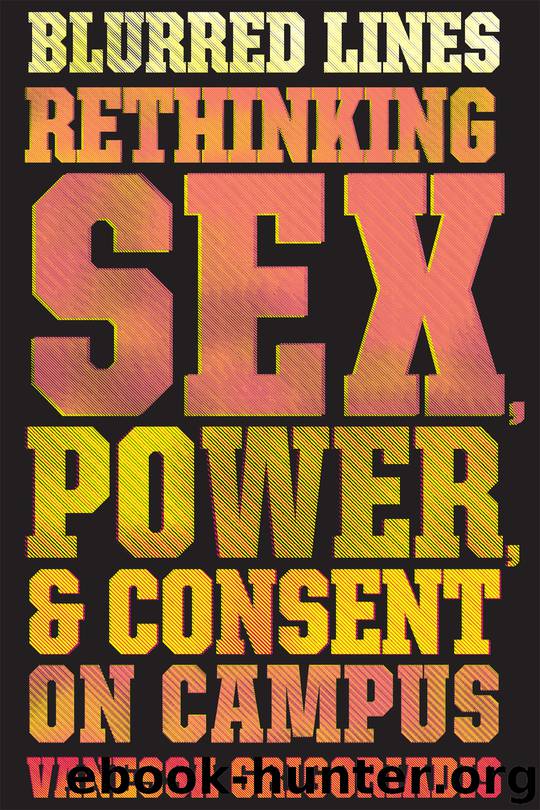Blurred Lines by Vanessa Grigoriadis

Author:Vanessa Grigoriadis
Language: eng
Format: epub
Publisher: Houghton Mifflin Harcourt
Dead Meat
The truth is that predators come in all stripes—serial and not, frat brothers and not. I heard a story about a couple of DJs at one school assaulting girls. I even heard that about some student leaders of sexual-assault orientation programs. At Ohio State, the marching band was accused of sexualized hazing that involved naked midnight sprints in the football field; of distributing nicknames like “Squirt” and “E Row Vibrator”; and of printing a “Boys of T Row” calendar featuring flirtatious trumpet players in stages of undress. There was also a byzantine story about a tuba player in a conflict with another tuba player about who got to dot the i in the Ohio formation, apparently the most prestigious honor for a member of the band. When I talk about this with the University of Michigan’s Elizabeth Armstrong, she doesn’t seem surprised. “Schools can be so particular,” she says. “This is about which group of men are given a pass.”
But that’s true only to a point. Frat brothers and athletes aren’t hugely overrepresented as assaulters, although most assaults happen after frat parties or parties in general. They are, however, overrepresented as gang rapists.
For “single perpetrator rape” in the United Educators’ report, 15 percent of the students were athletes and 10 percent were members of a frat. But these proportions were reversed for gang rapes. Gang rapes were 10 percent of United Educators’ claims. But many of them involved athletes (40 percent) and frat members (13 percent). (Interestingly, according to NYU’s Jessie Ford, female athletes have some of the lowest rates of assault on campus; she believes they’re protected by their social capital via their connection to activities the school values or possibly because the forty-eight-hour rule stops them from drinking many nights.)
According to Heather McCauley, an assistant professor teaching human development at Michigan State, data conflicts about whether athletes overall (the track team, volleyballers) are more likely to offend than the rest of the student population. Two sports stand out as exceptions: basketball and football. There’s a duh factor here, I know. Amy Schumer made this point best in her popular 2015 parody of TV’s high-school-football drama Friday Night Lights; in it, an upstanding coach declares a new rule of “No raping,” prompting cries of outrage at this attack on football tradition. The coach insists football is not about rape. “It’s about violently dominating anyone that stands between you and what you want,” he yells.
Both the most vicious and the saddest case of rape I came across—somehow emblematic of the whole issue—occurred in 2013 at Nashville’s Vanderbilt University among four Commodores football players and an unconscious student who’d passed out after a night of heavy drinking. These postadolescent men transformed into monsters, ruining their lives and their victim’s in the process.
Being unconscious, the woman, whom I’ll call Lisa, shared a characteristic of gang-rape victims: they’re usually passed out, underage, or mentally disabled. This case also defies standard assumptions in ways I’ve explored, suggesting the messier, more confounding reality represented by Swartout’s research.
Download
This site does not store any files on its server. We only index and link to content provided by other sites. Please contact the content providers to delete copyright contents if any and email us, we'll remove relevant links or contents immediately.
The Art of Coaching Workbook by Elena Aguilar(51076)
Trainspotting by Irvine Welsh(21568)
Twilight of the Idols With the Antichrist and Ecce Homo by Friedrich Nietzsche(18566)
Fangirl by Rainbow Rowell(9175)
Periodization Training for Sports by Tudor Bompa(8210)
Change Your Questions, Change Your Life by Marilee Adams(7684)
This Is How You Lose Her by Junot Diaz(6833)
Asking the Right Questions: A Guide to Critical Thinking by M. Neil Browne & Stuart M. Keeley(5708)
Grit by Angela Duckworth(5554)
Red Sparrow by Jason Matthews(5424)
Paper Towns by Green John(5136)
Room 212 by Kate Stewart(5070)
Ken Follett - World without end by Ken Follett(4682)
Housekeeping by Marilynne Robinson(4391)
The Sports Rules Book by Human Kinetics(4342)
Double Down (Diary of a Wimpy Kid Book 11) by Jeff Kinney(4240)
Papillon (English) by Henri Charrière(4227)
The Motorcycle Diaries by Ernesto Che Guevara(4050)
Exercise Technique Manual for Resistance Training by National Strength & Conditioning Association(4018)
